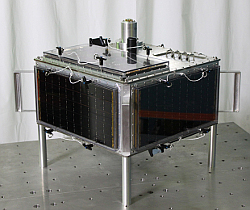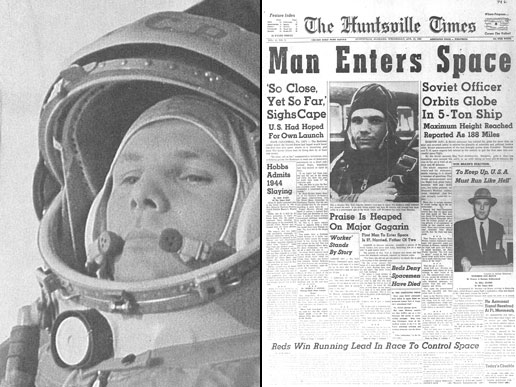Ham satellite broadcast celebrates 1st manned space flight
Last updated Apr 11, 2011 — 2717 views The 50th anniversary of the first-ever manned orbital space flight, by Soviet Cosmonaut Yuri Alekseyevich Gagarin, is being celebrated on April 12 with a two-day early activation of the “ARISSat-1” ham radio satellite aboard the International Space Station. If you can get your hands on a scanner or ham radio handy-talkie you can join in the celebration by listening to prerecorded messages from the satellite as it orbits the globe tonight and tomorrow.
The 50th anniversary of the first-ever manned orbital space flight, by Soviet Cosmonaut Yuri Alekseyevich Gagarin, is being celebrated on April 12 with a two-day early activation of the “ARISSat-1” ham radio satellite aboard the International Space Station. If you can get your hands on a scanner or ham radio handy-talkie you can join in the celebration by listening to prerecorded messages from the satellite as it orbits the globe tonight and tomorrow.
 The ARISSat-1 satellite (pictured on the right; click image for a larger view) is a project of “AMSAT,” the Radio Amateur Satellite Corporation. The satellite will not be released into autonomous orbit by the ISS until late July, 2011. However, in celebration of the 50th anniversary of Gagarin’s historic flight, the ISS crew is switching on the satellite for two days, so it can broadcast commemorative messages from within the ISS. (It will temporarily be hooked up to an antenna mounted outside the ISS.)
The ARISSat-1 satellite (pictured on the right; click image for a larger view) is a project of “AMSAT,” the Radio Amateur Satellite Corporation. The satellite will not be released into autonomous orbit by the ISS until late July, 2011. However, in celebration of the 50th anniversary of Gagarin’s historic flight, the ISS crew is switching on the satellite for two days, so it can broadcast commemorative messages from within the ISS. (It will temporarily be hooked up to an antenna mounted outside the ISS.)

On April 12, 1961, Yuri Gagarin became the first human to circle the Earth in space
The video below is a real-time recreation of Gagarin’s pioneering first orbit. It was shot primarily from space aboard the International Space Station, and includes audio from Gagarin’s original mission and a new musical score composed by Philip Sheppard. Enjoy…
First Orbit: The Movie
Short messages submitted by students throughout the world will be transmitted by the satellite as it traverses the globe. To conserve power, the transmissions will be consist 40-60 second broadcasts separated by two-minute breaks.
According to members of the AMSAT project team, it should be possible to hear transmissions using a simple scanner, such as a typical police scanner, or with a 2-meter ham radio “handy-talky” or receiver. The transmission frequency will be 145.950MHz. You’ll need to listen carefully during the period of time the satellite passes overhead.
You can determine when (in UTC) the ISS will pass over your area by entering your latitude and longitude coordinates into the appropriate fields on this web page. You can determine the coordinates of a location on Google Maps by right-clicking the map and selecting “What’s here?” When you do that, the coordinates will automatically pop up in the search box. UTC time conversion into various U.S. time zones is available here.
Below is a continually updated map showing the current location of the ISS, and hence the ARISSat-1 satellite.
Real-time location of the ISS
Additionally, it’s recommended that you equip your listening device with a 2-3 foot long whip antenna, rather than the typical shortened rubber ducky type antenna. Also, it’s important to orient the antenna properly, which is not the usual vertical orientation used for ground-to-ground communications. More specifics of what’s required to pick up the low-power signals from the distant satellite are in this document (PDF file).
Further information:
- Further information regarding the ARISSat-1 satellite project are available on the project’s website. A 27-page slide presentation describing the ARISSat-1 satellite and its internal systems is available here (PDF file).
- Details on the commemorative broadcast event are available from AMSAT’s website, here.
- A short video of Gagarin’s blastoff is available from NASA’s website, here (2MB mpeg video).
- Details on how to receive the ham radio satellite transmission are provided in this document (PDF download).
- A brief discussion of the satellite transmission event commemorating Gagarin’s flight is heard in this short clip (MP3 download) from last week’s NPR Science Friday program.
- Further information regarding Yuri Gagarin, his historic flight, and its influence on world events may be found in this Wikipedia article.
[Media credits… Russian commemorative postage stamp: Wikipedia; Gagarin photo beside newspaper front page: NASA; photo of ARISSat-1 satellite, AMSAT; YouTube video, FirstOrbit.org]